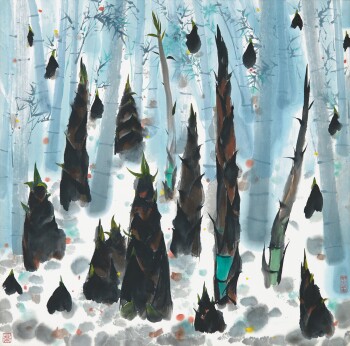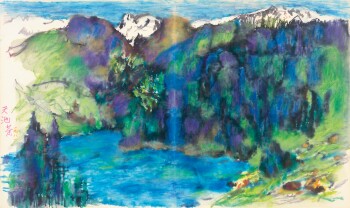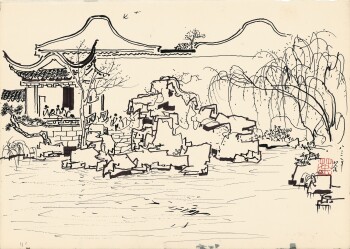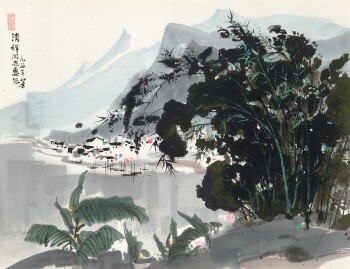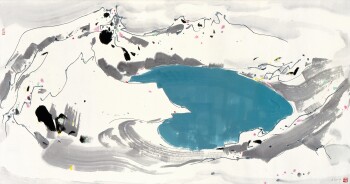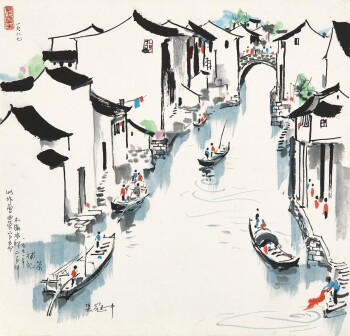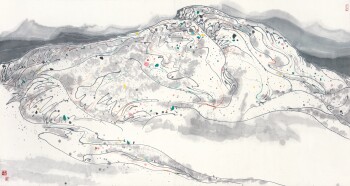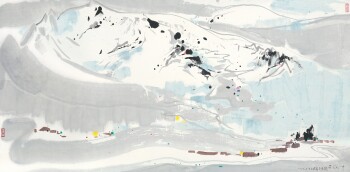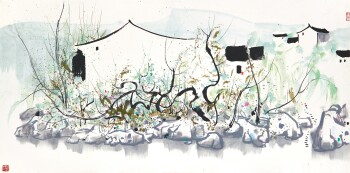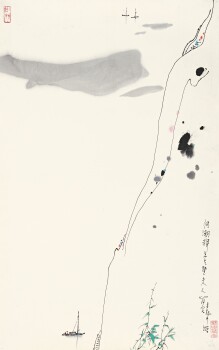W u Guanzhong spent his entire life dreaming of Jiangnan. He was born and grew up in Yixing in Jiangsu province. After he studied abroad in France in the 1940s, he never returned to settle in his hometown. Instead, he spent many years in northern China, where the climate was dry and loess sands hovered in the air. It was in his work that he expressed this persistent nostalgia. For many years, he traveled around small towns in Jiangnan, tirelessly carrying his painting materials across little bridges and through alleyways – seeking, recapturing and immortalizing the natural beauty and the vistas of the south.
"Jiangnan has a lot of spring shade and pale colors. A misty grove of trees and a small bridge over a flowing stream have pale grey tones. My own oil paintings begin with the gray tones of Jiangnan, and my hometown, seen through the eyes of its traveling son, was permeated with a bright silver-gray."
Ultimately, Wu Guanzhong returned to ink painting and moved toward a semi-abstract mode exemplified in his landscape works of the 1980s. In the spring of 1980, Wu Guanzhong took his students to Suzhou to sketch the Jiangnan scenery en plein air. He sketched and painted various notable Suzhou gardens and ancient towns, an area home to broad rivers and a dense network of waterways as well as typical Jiangnan water towns. Based on one of the sketches, he created the work Residences by the River.

In the painting, the arrangement of the houses shows a variety of heights, while the black forms of the windows and roofs constitute a stark contrast with the white walls. Together they delineate the spatial depth of the village. The narrow step street on the right side of the canvas extends from the village to the river, compelling viewers’ eyes to focus on the willows in front of the houses. Compared with his sketches, Household on Waters, this artwork emphasizes the form of the twisting and intertwining branches, while the white walls are also expanded to create a harmonizing visual effect with the vibrant willow trees. The artist painted the branches of diverse shapes with dark ink. These dynamic strokes break through the flourishing green leaves – the vivid dots of red, purple, blue and green – to bring a fresh vitality to this painting. This work is a testament to Wu Guanzhong's magic of transforming everyday scenery to endless possibilities of creation.
It was after his visit to Suzhou in 1980 that the artist began to paint the scenes of Jiangnan’s waterway and alleys, depicting ancient towns abuzz with activity. Using his preparatory sketch of Suzhou’s Shantang river, he later created many works of similar themes and compositions.

White-walled houses with black-tiled roofs line the flowing waterway. A bridge in the distance witnesses the comings and going of people in brightly colored garb who are either walking in the alleys or paddling their boats. These have all become fixtures of Wu Guanzhong’s oeuvre. Furthermore, the triangular roofs, elongated river and curved arch under the bridge all make up the lines and shapes of Wu's beauty of forms. Most satisfied with this edition of Jiangnan, the artist later picked this painting for Rong Bao Zhai to produce 200 woodblock prints.
The Artist's Relationship with Natural Landscapes
Wu Guanzhong often moved mountains and created scenes in his paintings. He did not want to be restricted to copying a scene in front of him. Instead, he boldly selected and recombined source materials. As with his paintings of the Heavenly Lakes, snow mountains, or even bamboo and trees, his depictions of Jiangnan would similarly blend Wu’s subjective feelings and creativity into a tasteful presentation of the water town.



